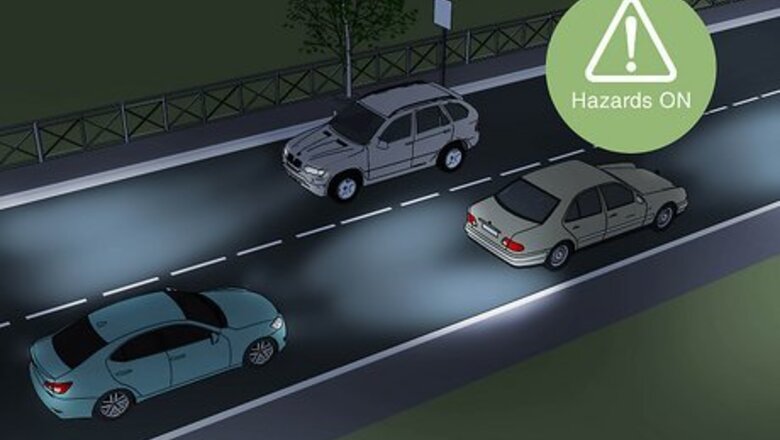
views
- Don’t panic. Put your hazards on, slow down, and look for somewhere absolutely safe to pull over.
- Call roadside assistance or your insurance company if you can’t get any friends or family to help and you aren’t sure what to do.
- Change the tire now if you aren’t in a rush and want to take a crack at it, but you can always leave the tire for tomorrow if you’re parked legally.
What to Do Right Now
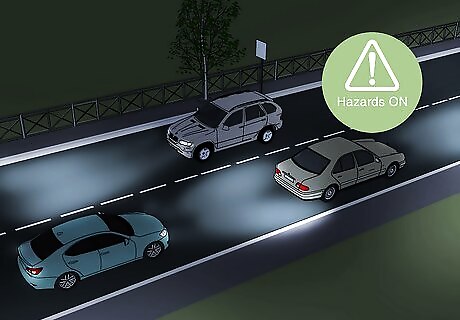
Don’t panic and turn your hazards on. As soon as you realize something may be wrong with your tire, put your hazards on. In most vehicles, press the button on your central console with a red triangle to turn the hazards on. This lets other drivers know something is wrong and you need space.
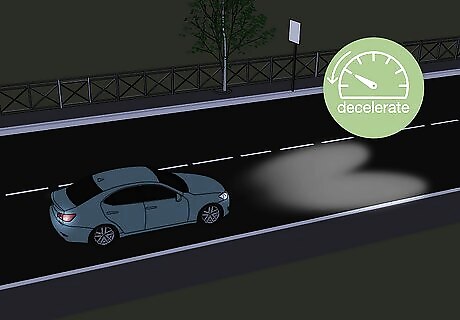
Slow down immediately. Driving on a flat tire is dangerous for your vehicle. It increases the odds you bend your rim or damage the sidewall, all of which will be much more expensive to fix than a damaged tire. You also lose a lot of handling control when you’re on 3 tires too, so go as slow as you safely can as you scan for a safe spot to pull over. You’re also more likely to blow another tire if you’re only driving on 3 tires, so don’t push it.
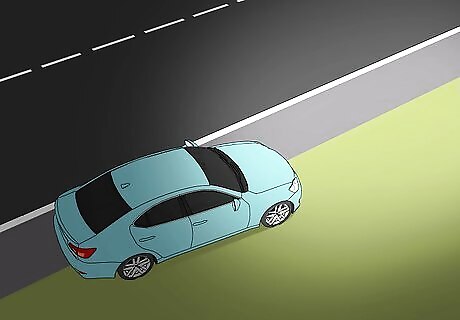
Pull over somewhere 100% safe. Since it’s dark out, look for somewhere well-lit that’s not going to be near the path of any other vehicles. It helps if your car is white or some other bright color, but you can never count on other drivers to be as alert as you’d be. As tire repair expert Howard Fleischmann puts it, “Go where you're safe.” If you see a tire shop, mechanic, gas station, or parking lot anywhere, pull in there. Otherwise, find a parking spot. If the flat is on the driver’s side and you plan on changing the tire yourself, don’t park on the street where you’ll be sticking out in the roadway as you work. Important note: Avoid pulling over on a highway at night. Drive slowly to the next exit and get off unless there is a multi-lane shoulder or an area dedicated to cars pulled over. You also need really good lighting if you’re going to change the tire yourself.
What if I can’t change a tire?

Reach out to a handy friend or roadside assistance if you need help. If you know your old man is awake and he’s a pro when it comes to all things vehicle-related, hit him up and ask him to meet you and help you out. Alternatively, contact roadside assistance if you have access to it. Your insurance may even cover this! Check your insurance card. If there’s a roadside assistance number, call that and explain your situation. Alternatively, you may pay for OnStar, AAA, or some other vehicle assistance separately. If you do, call them. If you live in a major city, look online for a roadside assistance department. Cities like New York, San Antonio, and Chicago have free roadside help if you reach out. Tire repair specialist Howard Fleischmann warns not to drive on a flat because "it will destroy the tire."
Do I have to change the tire at night?

No, you can always wait until tomorrow so long as you park legally. If you’ve decided to wait, park somewhere where the car won’t get towed for being parked illegally. If it takes an extra few blocks of driving to find a legal and safe parking spot, do it. Once you’re parked, shut the engine off and just come back tomorrow to change the tire. If you need to park at a local business, slide a note under their door to let them know you’re coming back for your car. Look around your vehicle for an old envelope or something. Grab a marker if you have one, but a pen is fine if you don’t. Write a short note explaining that your tire is flat and you’ll be back. Leave it on the dash. If you can’t leave a sign, roll the window down a bit and put a plastic bag, towel, or T-shirt in the middle before rolling it back up. This is a signal that the car isn’t abandoned.
Changing Your Tire
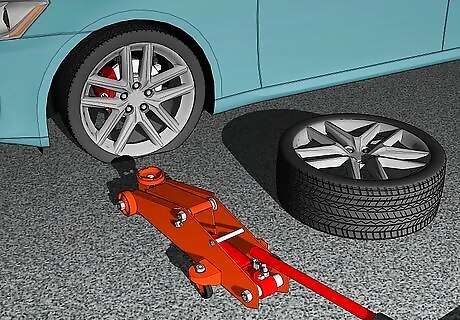
Remove the jack and spare from your trunk. Pop your trunk and look underneath the carpeted floor to find your spare tire kit. You should have a spare tire and a (probably handheld) jack and tire iron. Remove all of these items from the trunk and set them down next to your flat. Changing your tire at night isn’t difficult, but you do need some light. Turn a flashlight on or use the flashlight on your phone to help. If you do not have a full spare, jack, and tire iron, you cannot change your tire. Most of the time, the tire iron is also the device you use to raise the jack up, just FYI.
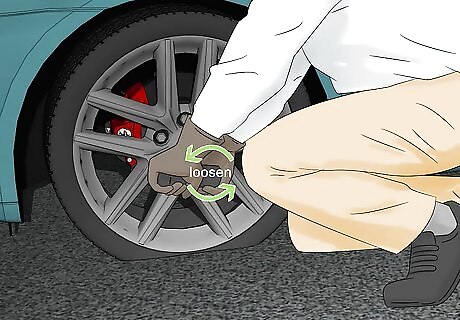
Loosen the lug nuts on the flat. Use the tire iron to unlock all of the lug nuts holding your flat tire in place. Your lug nuts should be attached pretty firmly, so you may have to put your weight into this. Don’t worry—you aren’t going to break anything. Once you’ve unlocked the lug nuts, loosen them until they’re weak enough that you can turn them by hand, but don’t remove them. You may have to pry off a hub cap to access the lug nuts. To do this, use your finger or a flathead screwdriver to

Raise your vehicle off the ground with your jack. Look and feel under the nearest door for a thin, metal railing that matches the opening on top of your jack. This is the frame of your vehicle. Set the top of the jack underneath this location and begin raising the jack. Continue raising the vehicle until the flat is high enough off the ground that you can install the spare. You might hear a scary creaking noise as your vehicle lifts off the ground. It’s just settling, don’t worry. Usually, you’ll use the tire iron to spin the nut on the end of the jack to raise the spring in the middle. Some jacks will have unique raising mechanisms, though. Refer to your manual if you can’t find the location for the jack. Some (mostly modern) vehicles come with a special platform for the jack.
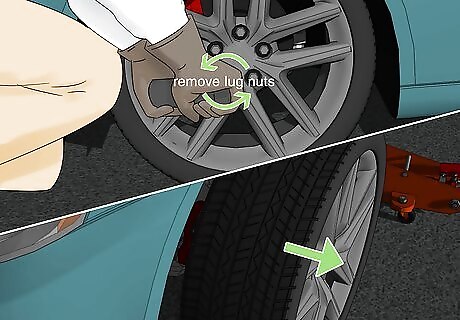
Remove the lug nuts and take the flat off. Use your hands to unscrew all of the lug nuts and set them aside. Then, carefully lift the flat tire up a little and pull it off of the axle. Set it aside as you finish up the rest of this process. It’s dark out, so pay special attention to where you put your lug nuts. You’ll need them to install your spare. When you’re done, throw the flat tire in your trunk or back seat. A mechanic will likely be able to patch and reinflate the tire.
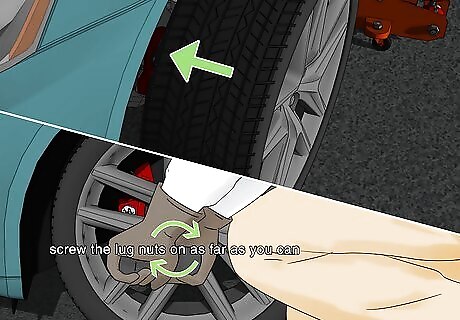
Install the spare and tighten the lug nuts. Slide your spare tire onto the same bolts you removed the flat tire from. Then, use your hands to screw the lug nuts on. Tighten the nuts as far as you can so that the tire is sitting flush against the axle. Do not try to tighten the nuts all the way while the tire is in the air. Most spares have an inside and an outside. The side with the air valve belongs on the outside.
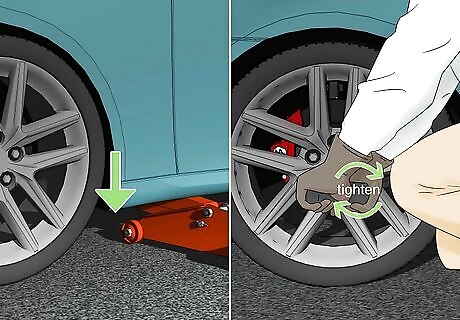
Lower the vehicle, remove the jack, and tighten the nuts. With your spare in the wheel well and attached to the axle, use your tire iron to begin lowering the vehicle. If you turn the jack nut clockwise to raise it, turn it counterclockwise to lower it. Continue lowering the vehicle until it’s on the ground and slide the jack out. Then, tighten the lug nuts with the iron as hard as you can. Follow the 50/50 rule when you have a spare on. You can drive no faster than 50 miles per hour (80 km/h) for 50 miles (80 km) before you need to replace the spare with a standard tire.
How do you avoid flat tires in the future?
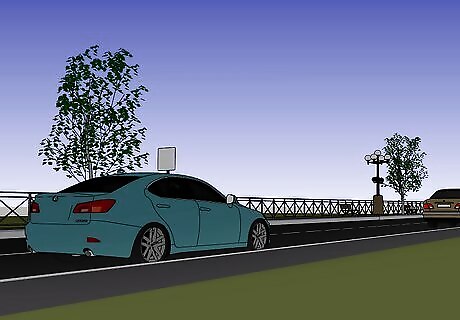
Keep your tires inflated and monitor the road as you drive. There are two major factors that increase the odds you get a flat: your tire quality, and where you drive. Buy quality tires and check the pressure regularly to ensure they aren’t under- or over-inflated. Also, pay careful attention to where you’re driving. It’s easy to zone out or focus exclusively on the car in front of you, but look out for obstacles, too! Areas around construction zones, roads with a lot of potholes, and gravel roads are all more likely to pop a tire. Get your tires inspected at least once a year. This way your mechanic will be able to spot any irregularities or problems. Don’t drive on your spare tire for more than 50 miles (80 km) and don’t go faster than 50 miles per hour (80 km/h). Your spare is likely to blow above those thresholds.











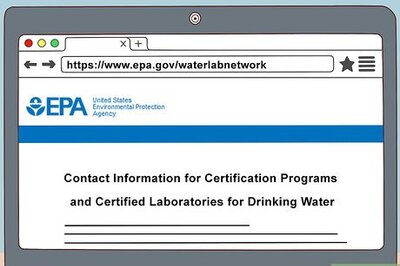







Comments
0 comment